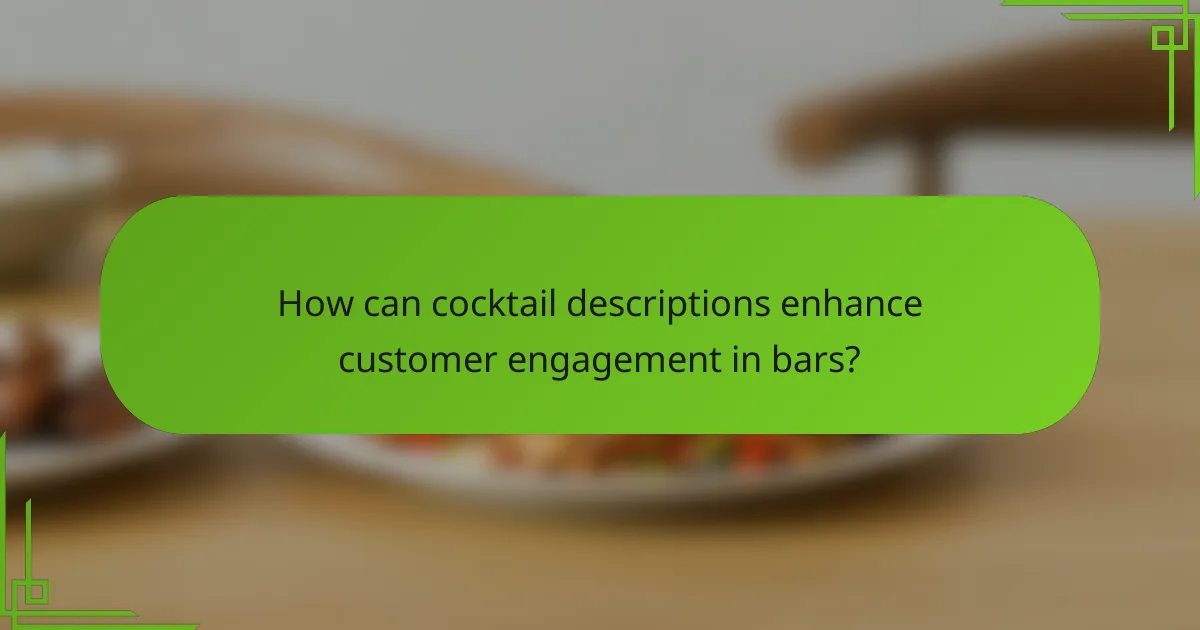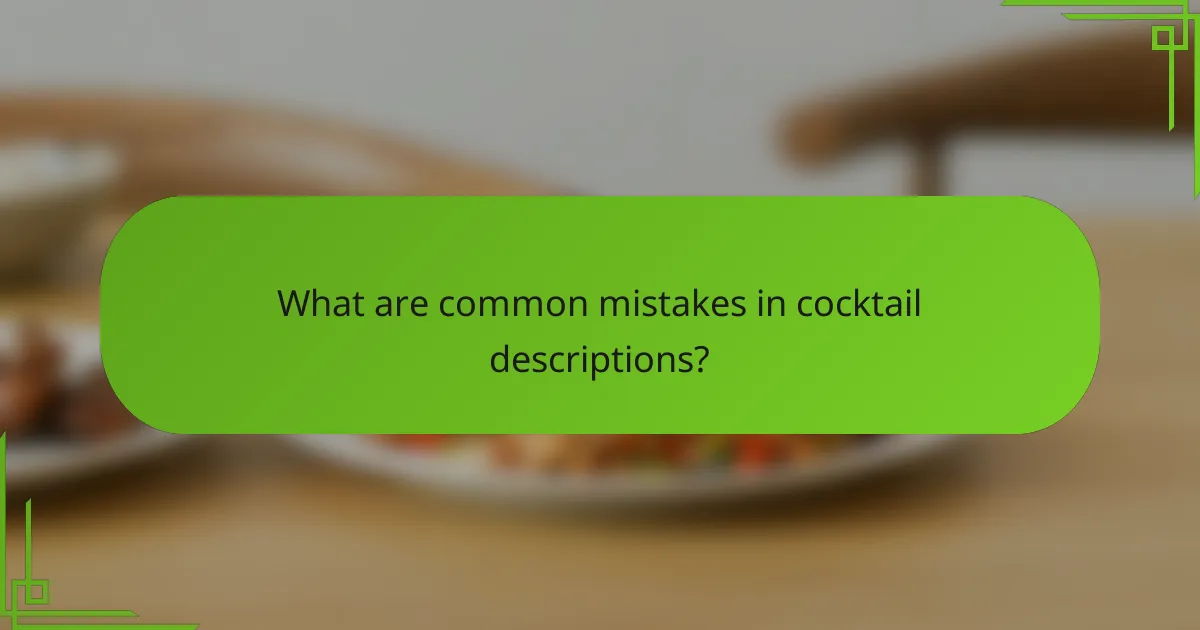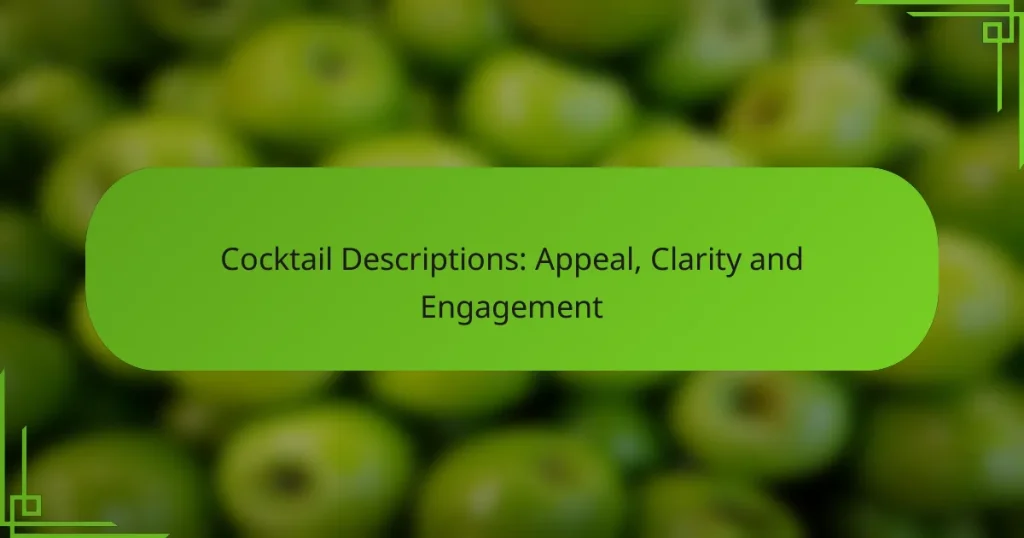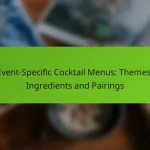Cocktail descriptions play a crucial role in enhancing customer engagement by making drinks more appealing and informative. By using vivid language and highlighting unique ingredients, these descriptions create a sensory experience that not only entices customers but also deepens their connection to the drink selection.

How can cocktail descriptions enhance customer engagement in bars?
Cocktail descriptions can significantly enhance customer engagement by making drinks more appealing and informative. Well-crafted descriptions not only entice customers but also provide insight into the flavors and ingredients, fostering a deeper connection to the drink selection.
Descriptive language captivates customers
Using vivid and evocative language in cocktail descriptions can draw customers in and spark their imagination. Phrases that evoke taste, aroma, and texture create a sensory experience, making the drink more enticing. For example, describing a cocktail as “a refreshing blend of zesty lime and smooth tequila” can make it sound irresistible.
Consider using adjectives that highlight unique aspects of the drink, such as “smoky,” “crisp,” or “velvety.” This not only paints a picture but also sets expectations about the flavor profile, encouraging customers to try something new.
Unique flavor profiles attract attention
Highlighting unique flavor profiles in cocktail descriptions can pique customers’ curiosity and encourage them to explore new tastes. When a drink features unexpected combinations, such as “spicy jalapeño paired with sweet mango,” it stands out on the menu and invites adventurous drinkers to take a chance.
To effectively convey these profiles, consider using comparisons to familiar flavors or experiences. For instance, describing a cocktail as “like a summer garden in a glass” can resonate with customers looking for something fresh and vibrant.
Visual appeal increases orders
The visual presentation of cocktails can significantly influence customer choices, and descriptions should emphasize this aspect. Phrases like “garnished with a vibrant twist of citrus” or “served in an elegant coupe glass” can enhance the perceived value of the drink.
Incorporating visual elements into the description can also create a sense of anticipation. For example, mentioning “a cascade of colorful layers” not only describes the drink but also makes it seem more appealing and Instagram-worthy, encouraging customers to order and share their experience.

What are effective strategies for writing cocktail descriptions?
Effective cocktail descriptions engage the reader by using vivid language, highlighting unique ingredients, and incorporating storytelling. These strategies create a sensory experience that entices customers and enhances their understanding of the drink.
Use sensory language for vivid imagery
Utilizing sensory language is essential for crafting cocktail descriptions that evoke taste, smell, and texture. Words that describe flavors—like “zesty,” “smooth,” or “rich”—help readers imagine the experience of enjoying the drink. For example, instead of saying “a fruity cocktail,” you might say “a refreshing blend of ripe strawberries and tart lime, finished with a hint of mint.”
Consider using metaphors and similes to create a more immersive experience. Phrases like “as refreshing as a summer breeze” or “a burst of sunshine in a glass” can paint a vivid picture that resonates with the audience.
Highlight unique ingredients
Focusing on unique ingredients sets your cocktail apart and piques interest. Mentioning rare spirits, locally sourced fruits, or artisanal mixers can enhance the allure of the drink. For instance, “crafted with small-batch gin infused with handpicked botanicals” immediately conveys quality and exclusivity.
When listing ingredients, consider using bullet points for clarity. This format allows readers to quickly grasp what makes the cocktail special. For example:
- Organic elderflower liqueur
- Freshly squeezed lemon juice
- House-made ginger syrup
Incorporate storytelling elements
Storytelling can transform a simple cocktail description into a memorable narrative. Share the inspiration behind the drink, such as a travel experience or a cultural tradition. For example, “Inspired by the vibrant streets of Havana, this cocktail captures the spirit of Cuba with its bold flavors and lively presentation.”
Additionally, consider creating a backstory for the cocktail, such as its creation by a renowned mixologist or its connection to a local event. This personal touch can foster a deeper connection with potential customers, making them more likely to order the drink.

How do cocktail descriptions impact sales in local bars?
Cocktail descriptions significantly influence sales in local bars by attracting customer interest and aiding in decision-making. Well-crafted descriptions can enhance the appeal of drinks, leading to increased orders and customer satisfaction.
Descriptive names boost customer interest
Descriptive names for cocktails can capture attention and spark curiosity. For instance, a name like “Tropical Paradise” evokes images of relaxation and escape, enticing customers to try it. Unique or playful names can differentiate a drink from standard offerings, making it more memorable.
Using ingredients or themes in the name can also create a connection with customers. Names that reflect local culture or seasonal ingredients can resonate more with patrons, encouraging them to explore the menu.
Clear descriptions reduce decision fatigue
Clear and concise descriptions help customers quickly understand what to expect from a cocktail. When descriptions highlight key ingredients and flavors, patrons can make informed choices without feeling overwhelmed. This clarity can lead to quicker decisions and increased orders.
For example, a description that states “A refreshing blend of gin, elderflower, and cucumber” provides essential information that guides customers. Avoiding overly complex jargon ensures that the menu remains accessible to all customers, regardless of their cocktail knowledge.
Engaging descriptions lead to higher sales
Engaging descriptions create a sense of excitement around cocktails, encouraging customers to order more. Descriptions that tell a story or evoke emotions can enhance the drinking experience, making patrons more likely to try something new. For instance, mentioning a cocktail’s origin or the inspiration behind it can add depth.
Bars can also use limited-time offers or seasonal specials in their descriptions to create urgency. Phrases like “available this summer only” can prompt customers to act quickly, boosting sales during peak times.

What are the key elements of a compelling cocktail description?
A compelling cocktail description captures the essence of the drink by highlighting its flavor, appearance, and ingredient quality. These elements engage the reader and entice them to try the cocktail, making the description an essential part of the overall experience.
Flavor profile and aroma
The flavor profile and aroma of a cocktail are crucial for attracting interest. Describing the balance of sweetness, bitterness, acidity, and any unique notes helps potential drinkers understand what to expect. For instance, a cocktail might feature citrusy notes from fresh lime, complemented by herbal undertones from basil.
When crafting a description, consider using evocative language that paints a sensory picture. Phrases like “refreshingly tart” or “richly spiced” can effectively convey the drink’s essence. Highlighting the aroma, such as “a fragrant bouquet of fresh herbs,” adds another layer of appeal.
Visual presentation and garnishes
The visual presentation of a cocktail plays a significant role in its allure. A well-crafted drink should be visually striking, often enhanced by garnishes that complement its flavors. For example, a vibrant red cocktail might be garnished with a twist of lemon peel to add a pop of color and a hint of zest.
When describing the visual aspects, focus on color, texture, and the overall arrangement. Terms like “crystal-clear” or “frosted glass” can create a vivid image. Mentioning garnishes, such as edible flowers or fresh fruit, can further entice the reader by suggesting a delightful experience.
Ingredient sourcing and quality
The sourcing and quality of ingredients significantly impact a cocktail’s appeal. Highlighting locally sourced or organic ingredients can attract health-conscious consumers and those interested in sustainability. For instance, a cocktail made with small-batch spirits or seasonal fruits can enhance its uniqueness and flavor.
When discussing ingredients, emphasize their quality and origin. Phrases like “handcrafted artisanal gin” or “locally harvested honey” convey a sense of care and craftsmanship. Providing insight into the sourcing process can also engage readers who appreciate transparency in their food and drink choices.

How can local bars optimize cocktail descriptions for SEO?
Local bars can enhance their cocktail descriptions for SEO by focusing on relevant keywords, local ingredients, and cultural elements. This approach not only improves search visibility but also attracts customers who appreciate local flavors and experiences.
Incorporate local ingredients
Using local ingredients in cocktail descriptions highlights the freshness and uniqueness of the offerings. Mentioning specific regional fruits, herbs, or spirits can resonate with customers looking for authentic local experiences. For example, a cocktail featuring locally distilled gin or seasonal berries can create a strong connection to the area.
Additionally, sourcing ingredients from nearby farms or markets can enhance the narrative around sustainability, appealing to environmentally conscious patrons. Highlighting these aspects in descriptions can set a bar apart from competitors.
Use geo-targeted keywords
Geo-targeted keywords are essential for improving local search rankings. Bars should include terms that reflect their location, such as the city or neighborhood name, in cocktail descriptions. Phrases like “Miami Mojito” or “Brooklyn Sour” can attract local customers searching for specific drinks in their area.
Incorporating these keywords naturally into the text helps search engines understand the relevance of the content. Avoid keyword stuffing; instead, aim for a seamless integration that enhances readability while boosting SEO.
Engage with local cocktail culture
Understanding and reflecting local cocktail culture in descriptions can greatly enhance customer engagement. This includes referencing popular local drinks, historical influences, or unique serving styles that resonate with the community. For instance, a bar in New Orleans might highlight the Sazerac’s rich history in its cocktail descriptions.
Engaging with local events, festivals, or competitions can also provide fresh content for descriptions. Featuring cocktails inspired by these events can attract attention and encourage patrons to visit during special occasions.

What are common mistakes in cocktail descriptions?
Common mistakes in cocktail descriptions often include using overly complex language and lacking clarity in flavor profiles. These issues can confuse readers and detract from the appeal of the drink.
Overly complex language
Using overly complex language in cocktail descriptions can alienate potential customers. Descriptions filled with jargon or elaborate terms may sound impressive but can make it difficult for readers to understand what to expect from the drink.
Instead, aim for straightforward language that conveys the essence of the cocktail. For example, instead of saying “a symphony of botanical notes,” simply describe it as “a refreshing gin with herbal undertones.” This approach makes the description more accessible and engaging.
Lack of clarity in flavor profiles
A lack of clarity in flavor profiles can lead to confusion about what a cocktail actually tastes like. If a description fails to specify the primary flavors or ingredients, customers may hesitate to order the drink.
To improve clarity, focus on the key flavors and how they interact. For instance, instead of saying “a complex blend,” specify that the cocktail features “sweet pineapple balanced with tart lime.” This gives readers a clearer picture of the taste experience they can expect.


